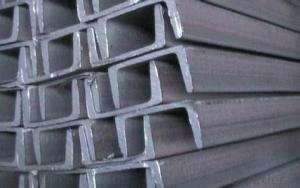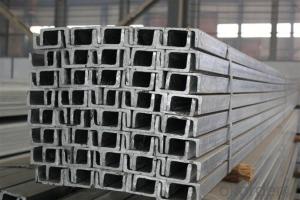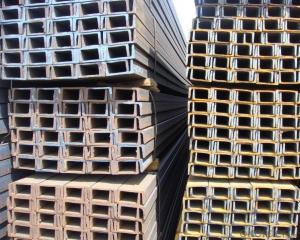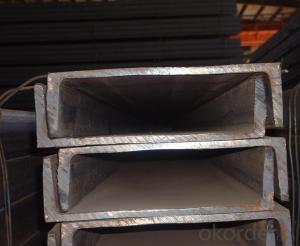Hot Rolled Steel U Channels Q345
- Loading Port:
- Tianjin
- Payment Terms:
- TT OR LC
- Min Order Qty:
- -
- Supply Capability:
- 200000 m.t./month
OKorder Service Pledge
OKorder Financial Service
You Might Also Like
Minimum Order Quantity: 25 Tons Unit: m.t. Loading Port: Xingang Port
Supply Ability: 1000 Tons Per Day Payment Terms: TT or L/C
Product Description:
Specifications of Hot Rolled Steel U Channels Q345:
Standard Applied: GB Standard, EN Standard(UPN), JIS Standard
Sizes: 50mm to 300mm
Material Grade: Q235B, Q345B, S235JR, SS400, ASTM A36
As shown in the figure:
| JIS U CHANNEL | Standard h | Sectional b | Dimension s | t | Mass: Kg/m |
| (mm) | (mm) | (mm) | (mm) | ||
| 50x25 | 50 | 25 | 3.0 | 6.00 | 2.37 |
| 75X40 | 75 | 40 | 3.8 | 7.00 | 5.30 |
| 75X40 | 75 | 40 | 4.0 | 7.00 | 5.60 |
| 75X40 | 75 | 40 | 4.5 | 7.00 | 5.85 |
| 75X40 | 75 | 40 | 5.0 | 7.00 | 6.92 |
| 100X50 | 100 | 50 | 3.8 | 6.00 | 7.30 |
| 100X50 | 100 | 50 | 4.2 | 6.00 | 8.03 |
| 100X50 | 100 | 50 | 4.5 | 7.50 | 8.97 |
| 100X50 | 100 | 50 | 5.0 | 7.50 | 9.36 |
| 125X65 | 125 | 65 | 5.2 | 6.80 | 11.66 |
| 125X65 | 125 | 65 | 5.3 | 6.80 | 12.17 |
| 125X65 | 125 | 65 | 5.5 | 8.00 | 12.91 |
| 125X65 | 125 | 65 | 6.0 | 8.00 | 13.40 |
| 150x75 | 150 | 75 | 5.5 | 7.30 | 14.66 |
| 150x75 | 150 | 75 | 5.7 | 10.00 | 16.71 |
| 150x75 | 150 | 75 | 6.0 | 10.00 | 17.90 |
| 150x75 | 150 | 75 | 6.5 | 10.00 | 18.60 |
Usage/Application of Hot Rolled Steel U Channels Q345:
The steel u channel can be applied to construction of warehouses, workshops, sport stadiums and car parks etc. In details, the steel u channel belongs to carbon structural steel which is applied to in the field of construction and machinery. The steel u channel is usually used for arch-itechtural structure, and they could be welded in order to support or hang a vari-ety of facilities. They are also usually used in combination with I beam. Generally,the steel u channel must possess perfect welding property, riveting property and mechanical property and so on.
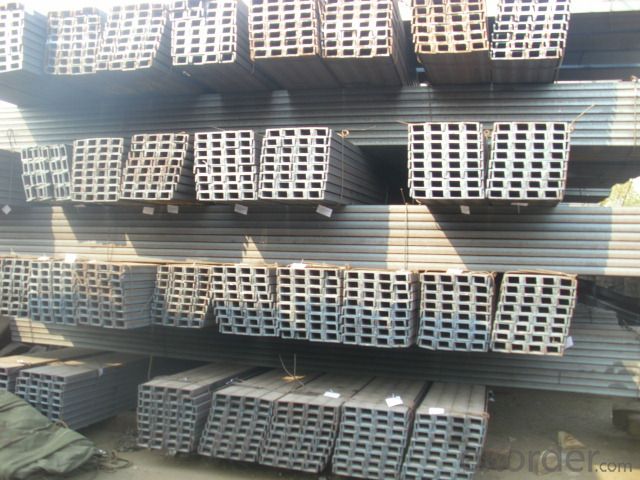
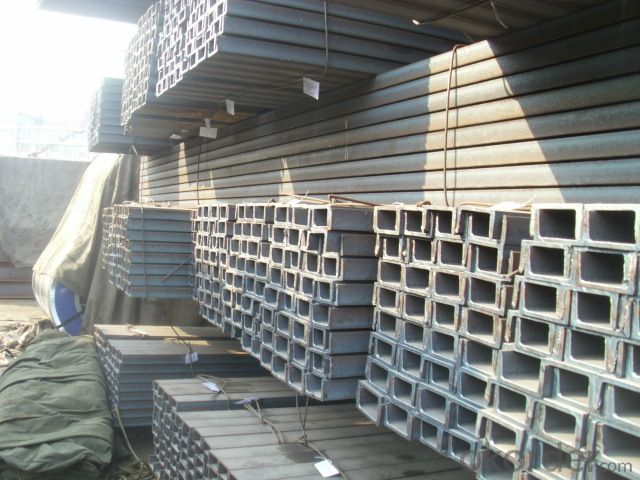
Package & Delivery: Hot Rolled Steel U Channels Q345
The steel u channel will be packed in bundle with steel wire at each end of every bundle and color marking in order to help the customer to recognize his goods more easily at sight.
And steel u channel could be loaded into 20ft or 40ft container, or by bulk cargo. If the weight of each bundle reaches less than 3.5 mt, the loading by break bulk cargo should be choosed. When the weight of each bundle reaches less than 3mt, the loading by container should be choosed.
As for the transportaion from mill to loading port, the truck will be usually used. And the maximum quantity for each truck is 40mt.
All in all, we could do in accordance with customer's request
- Q:How do you prevent galvanic corrosion in steel angles?
- One way to prevent galvanic corrosion in steel angles is by applying a protective coating or paint to the surface of the steel. This coating acts as a barrier between the steel and any other metal that may come into contact with it, thus inhibiting the electrochemical reaction that leads to galvanic corrosion. Additionally, using non-metallic or non-conductive materials between dissimilar metals can also help prevent galvanic corrosion. Regular inspection and maintenance to identify any signs of corrosion and taking appropriate measures promptly can further prevent the occurrence of galvanic corrosion in steel angles.
- Q:What are the different types of steel angles used in HVAC systems?
- HVAC systems commonly utilize several types of steel angles to ensure structural support and stability. These angles play a crucial role in maintaining the system's functionality. The most frequently employed steel angle in HVAC systems is the L-shaped angle. With its 90-degree angle, it is utilized to frame and support various components, including ductwork, vents, and equipment stands. Another angle commonly found in HVAC systems is the U-shaped angle, also known as a channel. It is used to create tracks or channels that securely hold and support pipes, conduits, and wiring. This angle ensures an organized and secure route for these components throughout the system. The Z-shaped angle is specifically designed for creating brackets and supports in HVAC systems. Its unique shape provides enhanced strength and stability, making it ideal for holding heavy equipment or reinforcing ductwork and other components. The T-shaped angle is another frequently used steel angle. It serves the purpose of joining and connecting different sections of ductwork or other components. Its design allows for easy assembly and disassembly, providing convenience for maintenance and repairs. Additionally, slotted angles are versatile and adjustable steel angles commonly used in HVAC systems. They feature a series of holes or slots along their length, facilitating the attachment of various components. This type of angle is often utilized to create custom supports or racks for HVAC equipment or to mount accessories like fans or filters. Overall, the diverse range of steel angles employed in HVAC systems ensures the necessary strength, support, and versatility required for proper installation and operation of the system.
- Q:What is the maximum length of a steel angle that can be transported?
- The maximum length of a steel angle that can be transported depends on various factors such as the transportation method, the size and weight restrictions of the vehicle used, and any legal limitations imposed by local regulations. However, in general, steel angles are commonly transported in lengths ranging from 20 to 40 feet, which are standard sizes for shipping containers and flatbed trucks.
- Q:What are the different methods of protecting steel angles against corrosion?
- Various methods are available to safeguard steel angles against corrosion, with the choice contingent upon factors such as the surrounding environment, budgetary constraints, and desired lifespan of the steel angles. Below are some commonly employed techniques: 1. Protective Coatings: The application of protective coatings stands as one of the most efficient approaches to prevent corrosion. Coatings like paint, epoxy, or polyurethane establish a barrier between the steel surface and corrosive elements. To ensure sufficient protection, multiple layers of these coatings should be applied. Regular inspections and touch-ups may be necessary to maintain the integrity of the coating. 2. Galvanization: Galvanizing steel angles involves coating them with a layer of zinc, creating a sacrificial barrier that corrodes before the steel does. This method proves highly effective in corrosion prevention, especially in harsh environments. However, it may not be suitable for aesthetic purposes as the zinc layer can alter the appearance of the steel. 3. Stainless Steel: Another means of corrosion protection is through the use of stainless steel angles. Stainless steel contains a substantial amount of chromium, which forms a passive layer on the surface, shielding it from corrosion. Stainless steel is particularly advantageous in corrosive settings like marine or chemical industries. 4. Powder Coating: The powder coating technique comprises the application of dry powder onto the steel angles, followed by heating to create a protective layer. This method offers exceptional corrosion resistance and can provide an aesthetically pleasing finish. Powder coating is commonly employed in architectural applications where aesthetics hold importance. 5. Cathodic Protection: Cathodic protection relies on an electrochemical process to thwart corrosion by designating the steel angle as the cathode in a galvanic cell. This is accomplished by connecting the steel to a sacrificial anode, often made of a more reactive metal such as zinc or magnesium. The anode corrodes in place of the steel angle, providing protection. 6. Regular Maintenance: Irrespective of the protective method employed, regular inspection and maintenance play a crucial role. This entails cleaning the steel angles, eliminating any debris or corrosive substances, and promptly rectifying any damaged or scratched coatings. Regular maintenance aids in identifying and addressing early signs of corrosion, thereby ensuring the prolonged lifespan of the steel angles. To determine the most suitable method for protecting steel angles based on specific requirements and conditions, it is imperative to consult corrosion experts or engineers.
- Q:Can steel angles be used for handrails?
- Yes, steel angles can be used for handrails. Steel angles are often used as a structural component for handrails due to their strength and durability. They can provide a sturdy and stable support for handrails in various applications.
- Q:Are steel angles resistant to pests and termites?
- Yes, steel angles are resistant to pests and termites as they are made of a material that pests cannot infest or damage.
- Q:How do steel angles perform in terms of impact resistance?
- Steel angles are known for their excellent impact resistance due to their structural properties and high tensile strength. They can effectively absorb and distribute the force from impacts, making them highly reliable in applications where impact resistance is crucial.
- Q:Can steel angles be used in high-rise or multi-story buildings?
- Yes, steel angles can be used in high-rise or multi-story buildings. Steel angles are commonly used in construction due to their high strength, versatility, and cost-effectiveness. In high-rise buildings, steel angles are often utilized for various structural elements such as beams, columns, and bracing systems. They provide excellent support for transferring loads and forces within the building, contributing to the overall stability and structural integrity. Moreover, steel angles can be easily fabricated and installed, allowing for efficient construction processes in large-scale projects. Therefore, steel angles are widely accepted and utilized in the construction of high-rise or multi-story buildings.
- Q:How do steel angles contribute to the overall safety of a building?
- Angle irons, also known as steel angles, play a vital role in improving the overall safety of a building. These structural elements have unique properties and advantages that make them widely used in construction. To begin with, steel angles contribute to the structural support and stability of a building. They are commonly utilized to reinforce and strengthen the framework, particularly at critical load-bearing points. By distributing and transferring weight and forces, steel angles prevent excessive deflection or deformation of the building, ensuring its integrity and stability, even under heavy loads or adverse conditions. This reinforcement is particularly crucial in tall buildings or structures located in earthquake-prone or high-wind regions. Moreover, steel angles enhance the safety of a building by acting as protective barriers or shields against potential hazards. For instance, they can be installed as guards or handrails on staircases, balconies, or elevated platforms. These barriers play a vital role in preventing accidental falls or injuries, creating a secure environment for occupants. Steel angles can also be utilized to create safety barriers around machinery or equipment, preventing unauthorized access or accidental contact. Additionally, steel angles contribute to enhancing fire resistance in buildings. Steel is inherently fire-resistant and does not contribute to the spread of flames. By incorporating steel angles into the structural design of a building, it becomes possible to effectively support fire-rated walls, partitions, or fireproof doors. This facilitates the compartmentalization of the building, slowing down the spread of fire and allowing occupants more time to evacuate safely. Furthermore, steel angles offer longevity and durability, making them an ideal choice for long-term safety. Steel is highly resistant to corrosion, weathering, and other environmental factors, ensuring the structural integrity of the building over time. This durability reduces the risk of sudden structural failures or collapses, thereby enhancing overall safety for occupants and nearby structures. In conclusion, steel angles play a significant role in improving the overall safety of a building. Their ability to provide structural support, act as barriers, enhance fire resistance, and offer durability make them crucial components for ensuring the stability and protection of a structure and its occupants.
- Q:What are the different types of steel angles used in automotive manufacturing?
- Automotive manufacturing relies on a variety of steel angles that play a crucial role in designing and constructing automotive structures and parts. Some of the commonly utilized steel angles in this industry include: 1. Equal Angle: This type of steel angle consists of sides of equal length, forming a 90-degree angle. In automotive manufacturing, equal angles find applications in chassis frames, suspension components, and brackets. 2. Unequal Angle: As the name suggests, unequal angles have sides of unequal lengths, creating a 90-degree angle. Automotive manufacturers employ unequal angles to fabricate components with specific dimensions and angles, such as door frames, body reinforcements, and support structures. 3. L Angle: Also known as angle irons, L angles possess two sides of equal length that form a 90-degree angle. They are extensively used in automotive manufacturing for various purposes, including reinforcing panels, mounting brackets, and structural supports. 4. T Angle: Resembling the shape of the letter "T," T angles consist of one long side and one short side forming a 90-degree angle. In automotive manufacturing, T angles play a significant role in joining different components like body panels, fenders, and roof structures. 5. C Angle: Referred to as channel angles, C angles have a C-shaped cross-section. These angles offer structural strength and rigidity, making them suitable for applications such as frame rails, roll cages, and support beams in automotive manufacturing. 6. Z Angle: Z angles feature a Z-shaped cross-section, resembling the letter "Z." They are commonly employed in automotive manufacturing to join and reinforce components like door frames, roof structures, and body reinforcements. These examples merely scratch the surface of the numerous types of steel angles employed in automotive manufacturing. Each type serves a specific purpose and possesses unique properties, such as strength, stability, and flexibility, to meet the diverse requirements of automotive applications.
1. Manufacturer Overview |
|
|---|---|
| Location | |
| Year Established | |
| Annual Output Value | |
| Main Markets | |
| Company Certifications | |
2. Manufacturer Certificates |
|
|---|---|
| a) Certification Name | |
| Range | |
| Reference | |
| Validity Period | |
3. Manufacturer Capability |
|
|---|---|
| a)Trade Capacity | |
| Nearest Port | |
| Export Percentage | |
| No.of Employees in Trade Department | |
| Language Spoken: | |
| b)Factory Information | |
| Factory Size: | |
| No. of Production Lines | |
| Contract Manufacturing | |
| Product Price Range | |
Send your message to us
Hot Rolled Steel U Channels Q345
- Loading Port:
- Tianjin
- Payment Terms:
- TT OR LC
- Min Order Qty:
- -
- Supply Capability:
- 200000 m.t./month
OKorder Service Pledge
OKorder Financial Service
Similar products
New products
Hot products
Related keywords
